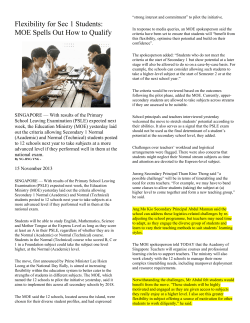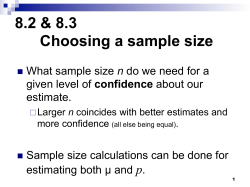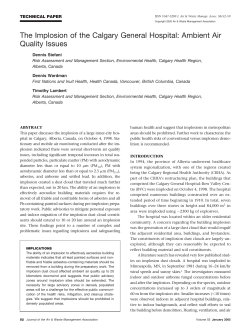
Interpretation of 24-hour sampling data: Development of 24-hour ambient air quality
Interpretation of 24-hour sampling data: Development of 24-hour ambient air quality criteria and their use in Ontario Denis Jugloff, Ph.D. Human Toxicology & Air Standards Section Standards Development Branch Ontario Ministry of the Environment Toronto, ON, Canada Air Quality in Ontario: Key Factors Influencing Air Quality 2 • Ontario’s air quality challenges arise from its economy and geography. • Ontario's population is concentrated in southern Ontario and, more particularly, in urban areas with heavy traffic volumes and intense residential development. • Parts of Ontario are highly industrialized. • Southwestern Ontario is also affected by transboundary pollution. How do we evaluate ambient air quality? • AAQCs: ambient air quality criteria • Used to evaluate regional air quality data from all sources (e.g., environmental assessments, assessment of general air quality in a community) • Developed based on science and a jurisdictional review • Established at concentrations that are protective against adverse effects that may occur during continuous lifetime exposure, with no consideration of compliance • Also used to set regulatory air standards under our Local Air Quality Regulation 3 AAQCs vs Air Standards They may be numerically the same but they are used differently. • AAQCs are used to assess regional air quality resulting from all sources. • Air standards are used to assess individual facilities Long range transport AAQC used to Air standard used to assess contributions of a contaminant from a single regulated source 4 assess contributions of a contaminant from all sources Ontario has over 300 AAQCs; latest introduced in 2011 Exposure Duration Mode of Action Window of Susceptibility Nature of Toxicity Effects from defined exposure period (e.g., blood lead level) Immediate effects from acute exposure (e.g. irritation) Effects from short-term exposure (e.g. developmenta l) and/or control daily variation Effects from long-term exposure (e.g. cancer) Effect-specific Time 1 hour 24 hours Annual NOTE: two different 24-hr AAQCs 5 Converted 24 hours Two Approaches 1) Effects-based 24-hr AAQCs • effects caused after short-term exposure (e.g. reproduction, development), or, if daily variation is a concern 2) Converted 24-hr AAQC • derived from annual-based AAQC protective of long-term exposure, and converted to 24-hr from annual AAQCs 6 Approach 1: Effects-based 24 hr AAQC The MOE assigns an averaging time of 24 hours to AAQCs based on… • Direct effects caused by short-term exposures (e.g., reproduction, development) or • Daily variation of the mean exposure, afforded by an annual average, is not considered acceptable 7 Effects-based 24 hr AAQC: Rationale Dioxins/Furans Exposure duration does not seem to be a determining factor in producing effects on the developing male reproductive system, as effects occur at similar doses in both short-term and long-term studies. Considering the existence of the critical windows of vulnerability for the effects on developing male reproductive organs, and the uncertainty in estimating fetal exposure, the MOE considered it prudent to use a 24-hour averaging time. Chromium Respiratory irritation represents a portal of entry effect resulting from the direct interaction of chromium with airway tissues. This effect is expected to occur relatively rapidly (compared to other effects that require longer exposure periods to manifest) and is expected to be concentration-dependent. Taken together, the above points supported a shorter averaging time (i.e. 24-hr) in order to prevent amortization over longer periods (i.e. annual) which could result in exposure to short-term peaks. 8 Effects-based 24 hr AAQC: Rationale Manganese Manganese is a well-established neurotoxicant, especially when exposure occurs via inhalation. The MOE considered that shortterm excursions of Mn levels during relatively brief but critical periods of early-life neurodevelopment could potentially interfere with these processes, and could result in subtle yet significant adverse neurological deficits with life-long implications. As a precautionary measure, Mn AAQC was assigned an a 24-hr averaging period. Quantitative derivation of AAQC / Qualitative assignment of averaging time 9 Approach 1: Effects-based 24 hr AAQC Outcomes of the Approach • If the AAQC is met, then no adverse effects are expected over continuous lifetime exposure • Reasonably expected to be protective of effects due to higher dose short-term / acute exposures • Not appropriate for assessing risks associated with discrete 24hour sampling data (i.e., single or periodic 24-hr exposures, such as with fires, spills) protective against effects that may occur during continuous lifetime exposure 10 Approach 2: Converted 24-hr AAQCs The MOE assigns annual averaging times for AAQCs based on… • Adverse effects caused by long-term exposures (e.g., cancer) The MOE uses a factor of 5 to convert from an annual averaging time to a 24-hr averaging time 11 Converted 24-hr AAQCs • Converting AAQCs with annual averaging times to 24-hr AAQCs via a meteorological-based conversion factor • If the converted 24-hour AAQC is met, it is assumed that the annual AAQC will not be exceeded Thus, two AAQCs are set for a single effect: • an effects-based annual average AAQC • a converted 24-hr AAQC, for interpreting 24 hr sampling data 12 Conversion Factors • The MOE uses a factor of 5 to convert from an annual averaging time to a 24-hr averaging time • For example, starting with an effects-based annual AAQC: AAQC (annual) = 1 µg/m3 then, the corresponding 24-hour AAQC is, AAQC (24 hr) = 5 µg/m3 13 Conversion Factors • The MOE used several sources of data to select a factor of 5 to convert from an annual to a 24-hr average • Derived from a modified power law relationship • Based on a combination of observed considerations, and guidance from the US EPA: • • • • data, meteorological monitored ambient SO2 in urban air and point sources atmospheric dispersion modelling of specific sources data from 8 large U.S. cities Ontario rural and urban data describes the relationship between a 1 hour average and an annual average Approach 2: Converted 24 hr AAQC • Relationships are site-specific, and typically depend on: • characteristics of emission sources: • source type / source height • receptor configuration: • height of receptor • distance to sources • meteorological/physical factors • atmospheric stability • topography • Although monitored data showed a range in the relationship between averaging times depending on location, conversion factors were selected to be conservative in most cases 15 Approach 2: Converted 24 hr AAQC Calculations The conversion factors used by the MOE are largely based on a powerlaw relationship of the form: Clong = Cshort (tshort/tlong)p Clong= the concentration for the longer averaging time Cshort= the concentration for the shorter averaging time Tshort = the shorter averaging time (in minutes) Tlong = the longer averaging time (in minutes) p = the power law exponent 16 For ambient air assessments, the MOE calls for using a value of p = 0.28 Cannual = C24hr (t24hr/tannual)0.28 Cannual = C24hr (24/8760)0.28 Cannual = C24hr (0.19) C24hr = Cannual / (0.19) In practice, the Ministry uses a factor of 0.2 to convert from an annual averaging time value to a 24-hour averaging time value, so that the 24-hour value is 5x the annual averaging time value 17 Converted 24 hr AAQC: Examples Benzene Cancer endpoint following chronic exposure 1,3-Butadiene Uranium Modelled 50-year exposure akin to lifetime exposure For example… Using the effects based annual AAQC of 0.45 µg/m3 for benzene as a foundation, the MOE established a converted 24-hr AAQC of 2.3 µg/m3 (0.7 ppb): C24hr = 0.45/0.2 C24hr = 2.3 18 Approach 2: Converted 24 hr AAQC Outcomes of the Approach • converted 24-hour AAQC is not directly linked to an effect and instead provides an indication whether the effects-based annual AAQC may be exceeded • has been criticized when used to set regulatory air standards for evaluating the contributions of contaminants to air by regulated emitters • generally considered to be protective against effects from short-term exposure • the converted 24-hour AAQC is not appropriate for assessing the health risk associated with non-continuous exposures, such as those resulting from spills or fires 19 Acknowledgements • Standards Development Branch: • • • • • • 20 Ms. Tania Onica (chromium) Ms. Olga Grabovska, DABT (dioxins) Dr. Ganesharem Balagopal (benzene) Dr. James Gilmore (uranium) Dr. Grazyna Kalabis (manganese) Mr. Andrew Chiu (retired) (1,3butadiene) • Environmental Monitoring and Reporting Branch: • • Dr. Robert Bloxam Ms. Yvonne Hall Appendix 21 24-hr AAQCs vs TCEQ 24 hr AMCV Ontario 24-hour AAQCs are based on health effects and are set at concentrations that are protective against effects that may occur during continuous lifetime exposure Texas 24-hour AMCVs are used to compare to measured 24hour ambient air concentrations, while acute 1-hr and chronic AMCVs are used to evaluate 1-hr measured concentrations of chemicals or calculated annual average concentrations, respectively. 22 Comparison of 24 Hour AAQC to the TCEQ 24-hr AMCV (all µg/m3) Ontario Texas Chemical Benzene 1,3Butadiene 23 Annual AAQC Converted 24-hr AAQC 1-hr acute AMCV 24-hr AMCV Annual AMCV 0.45 2.3 580 320 4.5 950 20 3700 2 10 (6-hr) Status of AAQCs • • There are over 300 AAQCs In 2011, our newest AAQCs that came into effect: 1,3-butadiene dioxin and furan compounds benzene manganese compounds chromium (0,II,III) nickel compounds hexavalent chromium uranium benzo-a-pyrene as a surrogate for PAHs • We continue to review science supporting the development of a new group of AAQCs mercury compounds copper compounds zinc compounds 24 24 arsenic compounds vanadium compounds ethylene Approach 1: Effects-based 24 hr AAQC Example: Dioxins / Furans Critical Study Faqi, A. S., Dalsenter, P. R., Merker, H.-J., & Chahoud, I. (1998). Reproductive toxicity and tissue concentrations of low doses of 2,3,7,8-tetrachlorodibenzo-pdioxin in male offspring rats exposed throughout pregnancy and lactation. Toxicol. Appl. Pharmacol., 150, 383-392. Exposure Weekly subcutaneous injections;♀ rats; pre-mating to lactation Effect Sperm parameters (production, transit rate, abnormalities) in male offspring at PN70 (puberty) and PN170 (adult) 24-hr Rationale Exposure duration does not seem to be a determining factor in producing effects on the developing male reproductive system, as effects occur at similar doses in both short-term and long-term studies. Considering the existence of the critical windows of vulnerability for the effects on developing male reproductive organs, and the uncertainty in estimating fetal exposure, the MOE considered it prudent to use a 24-hour averaging time. 25 Approach 1: Effects-based 24 hr AAQC Example: Chromium Critical Study Derelanko MJ, Rinehart WE, Hilaski RJ, Thompson RB, Löser E. 1999. Thirteenweek subchronic rat inhalation toxicity study with a recovery phase of trivalent chromium compounds, chromic oxide, and basic chromium sulphate. Toxicol Sci. 52(2):278-88. Exposure Rats; basic Cr(III) sulphate; 6 hrs/day; 5 days/wk; 13 wks. Effect Increased total lung and trachea weight relative to body weight in male and female rats following respiratory irritation 24-hr Rationale Respiratory irritation represents a portal of entry effect resulting from the direct interaction of chromium with airway tissues. This effect is expected to occur relatively rapidly (compared to other effects that require longer exposure periods to manifest) and is expected to be concentration-dependent. Taken together, the above points supported a shorter averaging time (i.e. 24-hr) in order to prevent amortization over longer periods (i.e. annual) which could result in exposure to short-term peaks. 26 Approach 1: Effects-based 24 hr AAQC Example: Manganese Critical Study Roels, H.A., Ghyselen, P., Bucher, J.P., Ceulemans, E. and Lauwerys, R.R. 1992. Assessment of the permissible exposure level to manganese in workers exposed to manganese dioxide dust. Br J Ind Med 49:25-34. Exposure Occupational: 5.3 years (range of 0.2-17.7 years) Effect Eye-hand coordination as a neurofunctional end-point in workers 24-hr Rationale Manganese is a well-established neurotoxin, especially when exposure occurs via inhalation. The MOE considered that shortterm excursions of Mn levels during relatively brief but critical periods of early-life neurodevelopment could potentially interfere with these processes, and could result in subtle yet significant adverse neurological deficits with life-long implications. As a precautionary measure, Mn AAQC was assigned an a 24-hr averaging period. 27 Approach 2: Converted 24 hr AAQC Example: Benzene Critical Study Rinsky et al., 1981, 1987; Paustenbach et al., 1993; Crump and Allen, 1984; Crump, 1992, 1994; U.S. EPA, 1998; U.S. EPA, 2000 Exposure Pliofilm workers; 15+ years of exposure Effect Acute Myeloid Leukemia (AML) Annual Rationale Cancer endpoint following chronic exposure The MOE established a converted 24-hr AAQC of 2.3 μg/m3 (0.7 ppb) for benzene, using the effects based annual AAQC of 0.45 μg/m3as a foundation: C24hr= 0.45/0.2 C24hr= 2.3 28 Approach 2: Converted 24 hr AAQC Example: 1,3 Butadiene Critical Study Delzell, E., Sathiakumar, N., Macaluso, M., Hovinga, M., Larson, R., Barone, F., Beall, C., Cole, P., Julian, J., and Muir, D.C.F. 1995. A Follow-Up Study of Synthetic Rubber Workers. Prepared for the International Institute of Synthetic Rubber Workers, October 2, 1995. (and follow-up studies) Exposure 4,863 female styrene-butadiene rubber workers; up to 20+ years exposure Effect Leukemia Annual Rationale Cancer endpoint following chronic exposure The MOE established a converted 24-hr AAQC of 10 μg/m3 (4.5 ppb) for 1.3butadiene, using the effects based annual AAQC of 2 μg/m3 as a foundation: C24hr= 2.0/0.2 C24hr= 10 29 Approach 2: Converted 24 hr AAQC Example: Uranium Critical Study Zamora et al. 1998; United Kingdom’s Royal Society 2001; Chen et al., 2004; Li et al., 2005 Exposure Modelled uranium accumulation in the kidney over a 50-year exposure period Effect Kidney toxicity Annual Rationale Modelled 50-year exposure akin to lifetime exposure The MOE established a converted 24-hr AAQC of 0.15 μg/m3 for uranium and uranium compounds, using the effects based annual AAQC of 0.03 μg/m3 as a foundation: C24hr= 0.03/0.2 C24hr= 0.15 30 How the MOE sets AAQCs • • An AAQC is an effects based concentration of a contaminant in air (expressed in micrograms per cubic meter of air (µg/m3)) below which adverse effects are not expected to occur – associated with an averaging time To set an AAQC, the MOE: • Reviews: – – • Identifies: – – 31 available/critical scientific information related to direct health, environmental or other effects science behind other jurisdictional limits (federal, state, provincial, international) and:: appropriate sensitive receptor critical exposure at which an adverse effect may occur Direct vs Indirect Effects • Direct effects • • result from the contaminant itself (e.g., respiratory effects of VOCs) Indirect effects • result from the contaminant transforming in the environment and then causing an adverse effect (e.g., CVD effects from smog, formed from VOCs) • • • Generally, adverse effects after long-term exposures, but some after short-term exposures (e.g. reproductive effects, developmental) Assumed to have a threshold Uncertainty factors may be applied Health Effects without Thresholds (carcinogens): • • Theoretically assumed NOT to have a threshold – Handled as if any level of exposure is associated with a potential cancer risk threshold Exposure Concentration Observed Effects Risk Health Effects with Thresholds (noncarcinogens): • Response How the MOE sets AAQCs (2) Extrapolated Risk Exposure Concentration 32
© Copyright 2025


















